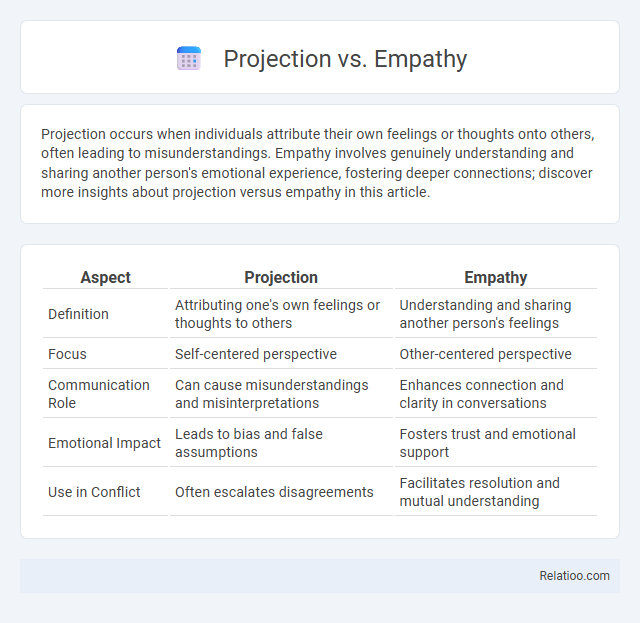Projection occurs when individuals attribute their own feelings or thoughts onto others, often leading to misunderstandings. Empathy involves genuinely understanding and sharing another person's emotional experience, fostering deeper connections; discover more insights about projection versus empathy in this article.
Table of Comparison
| Aspect | Projection | Empathy |
|---|---|---|
| Definition | Attributing one's own feelings or thoughts to others | Understanding and sharing another person's feelings |
| Focus | Self-centered perspective | Other-centered perspective |
| Communication Role | Can cause misunderstandings and misinterpretations | Enhances connection and clarity in conversations |
| Emotional Impact | Leads to bias and false assumptions | Fosters trust and emotional support |
| Use in Conflict | Often escalates disagreements | Facilitates resolution and mutual understanding |
Understanding Projection: Definition and Examples
Projection is a psychological defense mechanism where individuals attribute their own unwanted feelings or thoughts onto others, often to avoid facing internal conflicts. For example, someone who feels anger but cannot accept it may accuse others of being hostile or aggressive. Understanding projection helps identify how unconscious biases influence interpersonal dynamics and promotes self-awareness in emotional regulation.
What is Empathy? A Semantic Breakdown
Empathy is the cognitive and emotional ability to understand and share the feelings of another person by mentally placing oneself in their situation, which differs fundamentally from projection where one attributes their own emotions or thoughts onto others. Unlike projection, empathy involves active perspective-taking and emotional resonance without distortion, fostering genuine connection and understanding. This process is critical in social interactions, enhancing communication, reducing conflicts, and promoting emotional support.
Key Differences Between Projection and Empathy
Projection involves attributing one's own thoughts, feelings, or motives onto another person, often unconsciously, leading to misunderstandings in interpersonal communication. Empathy is the ability to accurately recognize and share the emotions of others, fostering genuine connection and emotional support. The key difference lies in projection's self-centered bias versus empathy's other-focused understanding, which impacts relationship dynamics and emotional regulation.
Psychological Roots of Projection
Projection involves attributing one's own unacceptable thoughts or feelings to others, rooted in defense mechanisms developed to reduce internal anxiety. Empathy entails understanding and sharing the emotions of others without distorting or misattributing them, reflecting emotional intelligence and social connectedness. The psychological roots of projection lie in unconscious processes where repressed impulses are externalized to avoid self-confrontation and maintain a cohesive self-image.
The Neuroscience Behind Empathy
The neuroscience behind empathy reveals that it involves the activation of mirror neurons in the brain, which enable you to internally simulate and understand others' emotions. Projection, in contrast, stems from cognitive biases where personal feelings are incorrectly attributed to others, without engaging these empathetic neural circuits. Understanding these differences can enhance your emotional intelligence by fostering genuine connection rather than misinterpretation.
How Projection Affects Relationships
Projection in relationships often leads to misunderstandings and conflicts as individuals attribute their own feelings or insecurities onto their partners, distorting reality and undermining trust. Empathy, by contrast, fosters deeper connection and emotional support through genuine understanding and validation of a partner's experience. Recognizing and managing projection is crucial to building healthier communication and emotional intimacy in relationships.
The Role of Empathy in Effective Communication
Empathy plays a crucial role in effective communication by allowing you to understand and share the feelings of others, fostering trust and clarity. Unlike projection, which involves attributing your own emotions or motives to someone else, empathy requires active listening and genuine emotional connection to bridge gaps in understanding. By developing empathy, you enhance interpersonal relationships and reduce misunderstandings, making communication more meaningful and impactful.
Common Misconceptions: Projection vs. Empathy
Projection is often mistaken for empathy, but while empathy involves understanding and sharing another person's feelings from their perspective, projection entails attributing one's own emotions or traits onto others. A common misconception is that projecting feelings onto someone else is a form of emotional insight, whereas it typically reveals unresolved internal conflicts rather than genuine connection. Recognizing the difference is crucial for emotional intelligence, as empathy fosters positive relationships, while projection can lead to misunderstandings and conflict.
Strategies to Move from Projection to Empathy
Moving from projection to empathy requires cultivating self-awareness to recognize when your thoughts and feelings are being inaccurately attributed to others. Practicing active listening and validating others' experiences allows you to shift focus from your own biases to understanding their perspective. You can strengthen emotional intelligence by regularly reflecting on your assumptions and seeking feedback to foster genuine empathetic connections.
The Importance of Self-Awareness in Emotional Interactions
Self-awareness plays a critical role in distinguishing projection from empathy in emotional interactions by enabling individuals to recognize their own biases and feelings before interpreting others' emotions. Projection involves attributing one's own unwanted feelings to others, which can distort communication and hinder genuine understanding. Developing self-awareness fosters empathy by promoting accurate emotional attunement and reducing misinterpretations caused by projection, thus enhancing effective interpersonal connections.

Infographic: Projection vs Empathy
 relatioo.com
relatioo.com